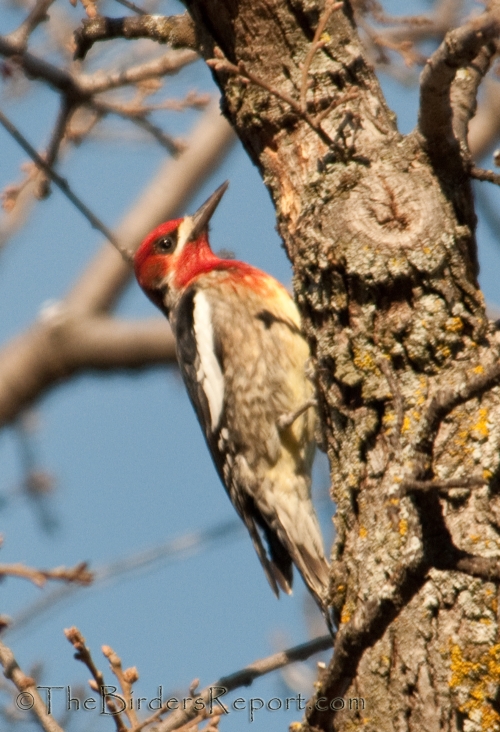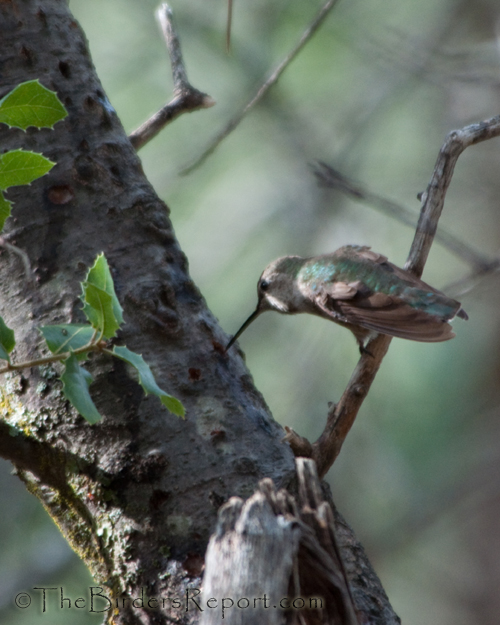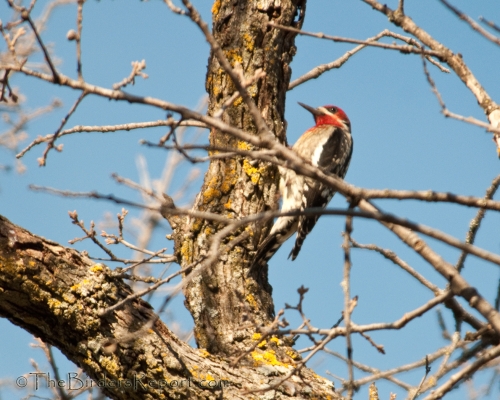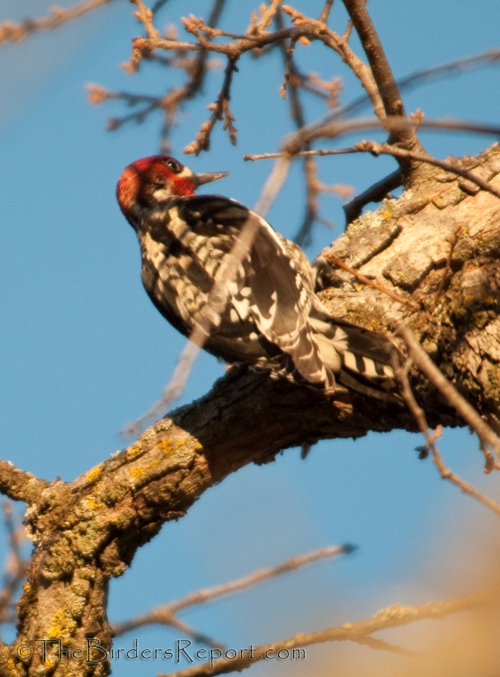 Red-breasted Sapsucker (Sphyrapicus ruber) photos by Larry Jordan
Red-breasted Sapsucker (Sphyrapicus ruber) photos by Larry Jordan
I found this Red-breasted Sapsucker (Sphyrapicus ruber) at Lema Ranch the other day as I was checking on my Bluebird Trail there. As I photographed this bird and followed its movements around the oak tree I discovered something about sapsuckers that I didn’t know. Sapsuckers tend and defend their sap wells.
I assumed that this bird was feeding on something, either arthropods or sap, but as other birds landed in the oak tree, it would always chase them off. To the point of making sure that any other birds landing in this tree, left this tree. I watched this behavior for about thirty minutes, thinking that possibly this bird just didn’t want to share a food rich resource.
When I began to research this phenomenon, I discovered that sapsuckers “create elaborate systems of sap wells and maintain this resource throughout the day to ensure sap production. Because of this large investment in maintenance, sapsuckers defend wells from other sapsuckers, as well as from other species.1“
If you look at the photo at the top of this post, it looks like a fresh sap well directly in front of the bird’s beak. I think that this bird had sap wells all over this tree and on this very warm day it was maintaining those sap wells and keeping all other birds way.
According to Birds of North America Online, “other species make use of sapsucker wells to supplement their food intake with sap or with insects attracted to the sap. Rufous Hummingbirds, for example, appear to be closely associated, ecologically, with both Red-breasted and Red-naped sapsuckers; they place their nests near sap wells, follow sapsuckers in their daily movements, and may even time their migration to coincide with that of sapsuckers so they can feed off the sap wells.1” Who woulda thought?
Back in the summer of ’09 I wrote a post on a Juvenile Nuttall’s Woodpecker that was foraging in an oak tree and an Anna’s Hummingbird that was feeding out of the sap wells in that tree. You can see the multitude of sap wells in this live oak tree as the hummingbird feeds.

It’s amazing the things you can discover while researching birds and their behaviors. It is one of the things I love about bird blogging.
To see more great bird photos, come on over to World Bird Wednesday and bring your own bird photos!
References: 1 Birds of North America Online











Comments on this entry are closed.
Fascinating info on the sapsuckers! And the hummers, too. I’ll have to be on the watch for this behaviour next time I see them.
Fascinating facts and pictures Larry.
You are so right too; I’m always learning more through blogging.
Great post- we’ve had a family of sapsuckers in the birch tree across the street for a couple of summers now. There are literally about 100 wells! There are holes everywhere.
Very informative post! That Sapsucker is a lovely bird!
I just quadrupeled my Sapsucker knowledge. Excellent captures of the subject birds and great research to share. What a fortuitous shot of the hummer at the sap well. It really topped off a great post!
Great photos and very interesting post. I keep wondering if we have similar behavior in birds out here.
thats an amazing bit of bird behavior! We have the yellow bellied sapsucker here they especially love the Tulip Populars and they actually killed a couple of our mature trees–lately I dont see as many-I had no idea a hummingbird would drink the sap! Great photos and a great observation!
fascinating behavioral account! love that you got a shot of the hummer using the sap wells!
Great series, Larry. Boom & Gary of the Vermilon River, Canada.
Great info and photos of some beautiful birds. I love the Sapsucker .
Interesting post. The sap wells look like they’re shaped differently than the Yellow-bellied Sapsuckers in my neck of the woods.
Nice series, and I especially like the hummingbird at the wells.
Wonderful pics and fascinating info of sapsuckers’ maintenance of sap wells. I have an ash tree in my yard which is pockmarked with sap wells and I have noticed that the sapsucker stays on the tree of a long time. Now I know why!
Bird behavior is so interesting,it`s so nice to share & learn from each other on here.I think we have sapsuckers,but I`ve not seen one…yet.I would not have guessed that about the hummingbirds either,thanks for sharing,phyllis
That’s so fascinating. I have never even heard of this gorgeous bird, let alone knew that they were capable of the things they do.
Lovely shots and great Info!
awww i really love these guys. It was so fun seeing them in the Sierra this summer, they always make me smile. Great shots, glad you put these guys up!
Hi Larry, you have illustrated how sapsuckers earned their names. Just last weekend I took a long overdue weekend nature trip, to a state park in southern TX. I witnessed a Yellow-bellied Sapsucker drilling wells, and quite a few Ruby-crowned Kinglets waiting their turn. Your sapsucker holes are indeed different – not the horizontal row of holes that I tend to see. Either way, it appears that the sapsuckers are important to the survival of other bird species. And the trees that might die along the way may just become excellent homes for cavity-nesting species. I guess it all works out. 😉
Nice post Larry – brings back memories of volunteering with Laskeek Bay Conservation Society up in Haida Gwaii. Part of our duties (when we weren’t banding Ancient Murrelets) was watching red-breasted sapsuckers at Western Hemlock well trees. Great way to spend a late spring day!
Yes, beautiful bird, but today, one has put several golf ball size holes in the window frame of my house! I don’t see any insects there and certainly no sap. I put pieces of aluminum foil hanging out of window but that hasn’t deterred him. Any ideas?